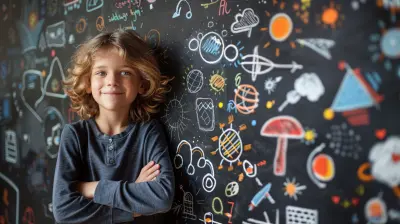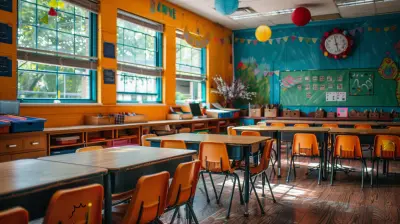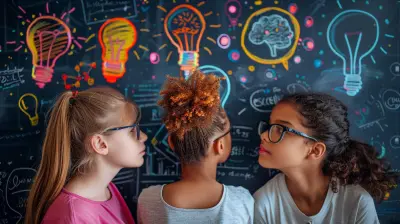Integrating Mindfulness and Well-Being into Daily Lesson Plans
23 November 2024
In today's fast-paced and often overwhelming world, students are more stressed than ever. Between academic pressures, social distractions, and the constant barrage of technology, it's no surprise that many young people struggle with anxiety and burnout. But what if there was a way to help students manage these challenges while also enhancing their learning experience?
Enter mindfulness and well-being practices. These approaches are becoming increasingly popular in schools, and for a good reason. When integrated into daily lesson plans, mindfulness and well-being techniques can help students develop emotional resilience, improve focus, and create a more positive learning environment.
But how do we incorporate these practices into our already-packed curricula? The good news is that implementing mindfulness doesn't require a complete classroom overhaul. In fact, just a few minutes of mindful practice each day can make a huge difference.
In this article, we'll explore the importance of integrating mindfulness and well-being into daily lesson plans, practical ways to do so, and the benefits students (and teachers!) can experience from these practices.

What is Mindfulness?
Before diving into how to integrate mindfulness into the classroom, let's start with the basics: what exactly is mindfulness?Mindfulness is the practice of paying full attention to the present moment without judgment. It's about being aware of your thoughts, emotions, and surroundings without getting caught up in them. This simple yet powerful practice helps individuals stay grounded, reduce stress, and increase focus.
Mindfulness isn't about clearing the mind or achieving a state of perfect calm. Instead, it's about acknowledging whatever is happening—whether it's excitement, frustration, or boredom—and allowing yourself to experience those emotions without getting overwhelmed.
It’s like standing on the shore and watching the waves crash in. You don’t have to get swept up in the current. Instead, you observe the waves, acknowledge their power, and stay grounded on the beach.

Why Should We Integrate Mindfulness into Lesson Plans?
You might be wondering, "Why should I bother with mindfulness in my lesson plans? Isn't teaching academic content enough?"Well, it turns out that mindfulness offers a host of benefits that can actually enhance students' academic performance, mental health, and overall well-being. Here's why it's worth considering:
1. Improved Focus and Attention
We live in an age of distraction. Between smartphones, social media, and constant notifications, students' attention spans are shorter than ever. Mindfulness helps students train their minds to focus on the present moment, making it easier for them to pay attention during class.Imagine trying to teach a lesson while your students are mentally miles away, thinking about their next TikTok video or what they're having for lunch. With mindfulness, students learn to gently bring their focus back to the task at hand, improving their ability to concentrate in class.
2. Reduced Stress and Anxiety
School can be a breeding ground for stress. From exams to peer pressure, students face a lot of challenges that can take a toll on their mental health. Introducing mindfulness into the classroom helps students develop coping mechanisms to manage stress and anxiety.Just a few minutes of mindful breathing or meditation can lower cortisol levels and help students feel more relaxed and ready to learn. It’s like hitting the "reset" button on a chaotic school day.
3. Enhanced Emotional Regulation
Let's be honest—students sometimes struggle with managing their emotions. Whether it's frustration over a difficult math problem or social drama with friends, emotions can run high in the classroom.Mindfulness teaches students how to observe their emotions without getting carried away by them. This emotional regulation is essential for maintaining a positive learning environment and preventing conflicts between students.
4. Promoting Empathy and Compassion
Mindfulness isn't just about self-awareness—it's also about building awareness of the world around us. By practicing mindfulness, students learn to cultivate empathy and compassion for others. This can lead to improved relationships with peers, fewer instances of bullying, and a more supportive classroom community.
Practical Ways to Integrate Mindfulness into Lesson Plans
Now that we've covered the benefits of mindfulness, let's get into the nitty-gritty: how can you actually integrate mindfulness and well-being practices into your daily lesson plans? Here are a few practical strategies to get you started.1. Start with a Mindful Moment
One of the easiest ways to incorporate mindfulness into your classroom is by starting each day or lesson with a "mindful moment." This could be a simple breathing exercise, a moment of silence, or a guided meditation.Encourage students to close their eyes, take a few deep breaths, and focus on the present moment. You can even guide them through a short body scan, where they bring awareness to different parts of their body, noticing any tension or sensations.
This practice not only helps students center themselves before diving into the lesson but also signals that the classroom is a safe, calm space where they can relax and focus.
2. Incorporate Mindful Breathing
Mindful breathing is a simple yet powerful tool that can be used throughout the day to help students manage stress and refocus their attention. Teach students to take slow, deep breaths, paying attention to the sensation of the air entering and leaving their bodies.You can incorporate mindful breathing into transitions between activities, before tests, or even during particularly challenging lessons. It's like giving students a mental "pause button" that they can press whenever they need a moment to collect themselves.
3. Mindful Listening Exercises
Incorporating mindfulness doesn't always have to be about quiet meditation. You can also introduce mindful listening exercises to help students build their focus and awareness.For example, play a nature sound, like the chirping of birds or the sound of rain, and ask your students to close their eyes and listen carefully. Afterward, have them describe what they heard in as much detail as possible. This helps students practice active listening and enhances their ability to concentrate.
You can even tie this into your lesson plan! For example, if you're teaching a music class, have students mindfully listen to a piece of music and analyze the different instruments or melodies.
4. Mindful Journaling
Writing can be a mindful activity, too. Encourage students to engage in mindful journaling, where they reflect on their thoughts, emotions, and experiences in a non-judgmental way. You might prompt them with questions like:- "What are you feeling right now?"
- "What was the best part of your day?"
- "What is something you're grateful for?"
Not only does this practice promote self-awareness, but it also gives students a chance to express their emotions in a healthy way.
5. Mindful Movement
For students who find it challenging to sit still, incorporating mindful movement can be a great alternative to seated meditation. Yoga, stretching, or even a short mindful walk around the classroom can help students release physical tension and stay present.Encourage students to move slowly and deliberately, paying attention to how their bodies feel with each movement. This practice can be especially helpful during long periods of sitting, like after lunch or during an extended class.
6. Gratitude Practice
Gratitude is a powerful tool for promoting well-being, and it can easily be integrated into your lesson plans. At the end of each day or week, ask students to write down or share something they are grateful for.This practice helps shift the focus away from stress and negativity, promoting a more positive mindset. Plus, it encourages students to recognize and appreciate the good things in their lives, no matter how small.

The Role of Teachers in Promoting Well-Being
As educators, we play a crucial role in fostering not only academic growth but also the emotional and mental well-being of our students. By modeling mindfulness ourselves, we can create a more supportive and nurturing environment for our students.It's important to remember that mindfulness is a practice—it's not about achieving perfection. There will be days when students are more distracted or resistant, and that's okay. The goal is to consistently offer opportunities for mindfulness and well-being so that students can develop these skills over time.
And here's the bonus: incorporating mindfulness into your teaching practice can benefit you, too! Teaching can be stressful, and having your own mindfulness practice can help you stay grounded, reduce burnout, and become a more effective educator.
Conclusion
Integrating mindfulness and well-being into daily lesson plans isn't just a passing trend—it's a powerful tool for enhancing student learning, emotional regulation, and overall classroom harmony. By incorporating simple practices like mindful breathing, journaling, and gratitude, we can help our students not only succeed academically but also thrive emotionally.So, why not give it a try? Start small, be consistent, and watch as your students become more focused, resilient, and compassionate individuals.
all images in this post were generated using AI tools
Category:
Lesson PlansAuthor:

Eva Barker
Discussion
rate this article
19 comments
Dash McWhorter
Integrating mindfulness and well-being into lesson plans is a powerful way to nurture not only academic growth but also emotional resilience in students. By prioritizing these practices, we create a positive learning environment that fosters curiosity, compassion, and lifelong success. Let's inspire minds and hearts together!
March 23, 2025 at 5:53 AM

Eva Barker
Thank you for your insightful comment! I completely agree—integrating mindfulness and well-being is essential for fostering both academic and emotional growth in our students. Let's continue to inspire and uplift together!
Brittany Phillips
Integrating mindfulness into lesson plans not only enhances student focus but also fosters emotional resilience. By prioritizing well-being, educators create a supportive environment that encourages holistic growth, empowering students to thrive academically and personally.
February 25, 2025 at 8:45 PM

Eva Barker
Thank you for highlighting the importance of mindfulness in education! I agree that fostering emotional resilience is key to supporting students' overall growth and success.
Viviana Murphy
Mindfulness enhances student focus and emotional resilience effectively.
February 10, 2025 at 12:20 PM

Eva Barker
Thank you for highlighting the benefits of mindfulness! Integrating it into lesson plans can indeed foster focus and resilience in students.
Bear McGonagle
Integrating mindfulness into daily lesson plans fosters not only academic growth but also emotional resilience. By nurturing students' well-being, we create a supportive environment that enhances focus, creativity, and overall learning experiences. Thoughtfulness leads to transformation.
February 1, 2025 at 4:57 AM

Eva Barker
Thank you for highlighting the powerful impact of mindfulness on both academic and emotional development. Your insights perfectly align with our goal of fostering a holistic learning environment.
Wyatt McAndrews
Embracing mindfulness in lesson plans not only enriches learning but also nurtures well-being. Let’s empower our students to thrive, cultivating resilience and focus for a brighter future!
January 29, 2025 at 8:12 PM

Eva Barker
Thank you! I completely agree—integrating mindfulness into lesson plans enhances both learning and well-being, fostering resilience and focus in our students. Together, we can create a brighter future for them!
Ford McClendon
Integrating mindfulness and well-being into daily lesson plans is essential for fostering a positive learning environment. By incorporating practices such as meditation, gratitude exercises, and mindful breathing, educators can enhance students’ focus, reduce anxiety, and promote emotional resilience, ultimately leading to improved academic performance and overall well-being. A transformative approach!
January 24, 2025 at 7:25 PM

Eva Barker
Thank you for your insightful comment! I completely agree that incorporating mindfulness practices can significantly enhance both student well-being and academic success.
Victor Kirkland
Love this approach! So helpful!
January 19, 2025 at 12:09 PM

Eva Barker
Thank you! I'm glad you found it helpful!
Blade Kline
This article insightfully emphasizes the importance of integrating mindfulness into lesson plans, highlighting its potential to enhance student well-being and focus. Such practices not only foster a supportive learning environment but also equip students with lifelong skills.
January 16, 2025 at 3:25 AM

Eva Barker
Thank you for your thoughtful comment! I'm glad you found the emphasis on mindfulness valuable for enhancing student well-being and focus.
Elowis McIntire
Integrating mindfulness isn’t just an add-on; it’s essential. Our classrooms must be sanctuaries of well-being, where students thrive mentally and emotionally. Let’s prioritize their holistic growth—no excuses, no compromises.
January 11, 2025 at 7:46 PM

Eva Barker
Absolutely! Mindfulness is crucial for fostering a supportive classroom environment that nurtures both mental and emotional well-being. Prioritizing this integration promotes holistic growth for our students.
Hunter Diaz
This article effectively highlights the importance of incorporating mindfulness and well-being practices into daily lesson plans. By fostering a positive classroom environment, teachers can enhance student engagement and emotional resilience. Practical strategies and insights provided here are essential for creating a holistic educational experience that prioritizes mental health alongside academic success.
January 4, 2025 at 2:00 PM

Eva Barker
Thank you for your thoughtful comment! I'm glad you found the article's strategies valuable for enhancing both engagement and emotional resilience in the classroom. Prioritizing well-being is crucial for a holistic educational experience.
Andrew Sharp
Embracing mindfulness in lessons nurtures both academic success and emotional resilience in students.
December 30, 2024 at 12:57 PM

Eva Barker
Absolutely! Mindfulness equips students with vital skills for both learning and life, fostering a balanced educational experience.
Helen McVicar
In the tapestry of teaching, weave moments of calm, Where mindfulness dances, and hearts find their balm. Each lesson a refuge, each breath a new start, Nurturing minds with compassion, connecting the heart. In this gentle embrace, education takes flight, Empowering all souls to shine their own light.
December 22, 2024 at 9:55 PM

Eva Barker
Thank you for beautifully capturing the essence of mindfulness in education! Your words perfectly reflect the transformative power of creating a calm, compassionate learning environment.
Eliana Miller
Integrating mindfulness into daily lesson plans not only enhances students' focus and emotional resilience but also fosters a nurturing environment. This holistic approach cultivates a balanced educational experience, promoting both academic success and personal growth.
December 16, 2024 at 8:19 PM

Eva Barker
Thank you for highlighting the importance of mindfulness in education! Integrating these practices truly benefits both academic outcomes and students' emotional development.
Faith Garcia
Zen vibes in math class!
December 13, 2024 at 7:49 PM

Eva Barker
Thanks for your feedback! Embracing mindfulness can truly enhance the learning environment.
Velvet West
This article sparks my curiosity! How can we effectively weave mindfulness practices into diverse subjects? I'm eager to learn about specific techniques that educators have found successful in fostering student well-being while enhancing engagement. Could small moments of mindfulness truly transform the classroom experience? Looking forward to exploring further!
December 4, 2024 at 9:26 PM

Eva Barker
Thank you for your enthusiasm! Integrating mindfulness can be as simple as starting each class with a brief breathing exercise or incorporating mindful reflection at the end of lessons. Techniques like mindful listening and movement can enhance engagement and well-being, fostering a positive classroom environment. Small moments of mindfulness can indeed transform the overall experience! Looking forward to sharing more insights.
Kane Henderson
“Mindfulness in lessons? Great idea! Now if only I could remember to breathe deeply before my morning coffee—priorities, right?”
November 30, 2024 at 4:48 AM

Eva Barker
Absolutely! Mindfulness is all about small, manageable steps—starting with something as simple as deep breathing can make a big difference, even before that morning coffee!
Natalie Kearns
Integrating mindfulness and well-being into lesson plans is a valuable approach that can enhance student engagement and emotional health, promoting a holistic educational experience for diverse learners.
November 28, 2024 at 1:48 PM

Eva Barker
Thank you for your insightful comment! Integrating mindfulness truly enriches the learning environment and supports the diverse needs of students.
Zevran Patterson
Essential approach for fostering student engagement and resilience.
November 27, 2024 at 3:24 AM

Eva Barker
Thank you! Fostering engagement and resilience through mindfulness truly transforms the learning experience.
Mateo Lozano
What a fantastic approach! Integrating mindfulness into lesson plans not only enhances student well-being but also fosters a positive learning environment. Excited to see how teachers implement these strategies!
November 26, 2024 at 2:04 PM

Eva Barker
Thank you! I’m glad you see the value in integrating mindfulness—it's all about creating a supportive atmosphere for our students. Excited to share more insights on implementation!
MORE POSTS

How Global Crises Influence Education Systems Worldwide

"Practical Strategies to Build Emotional Intelligence in the Classroom

Simplifying Complex Concepts with Visual Learning Lesson Plans

How Extracurriculars Encourage Creativity and Innovation

The Role of Standardized Tests in Graduate School Admissions

How to Create a Dynamic Learning Environment with Blended Learning

Building Resilience in Students: Psychological Approaches

Using Storytelling as a Tool for Creative Education

Making the Case for More Music in Schools

Encouraging Creative Collaboration Among Students

Why Learning Music Should Be Part of Every Curriculum

Fostering Autonomy in Learners for Long-Term Success